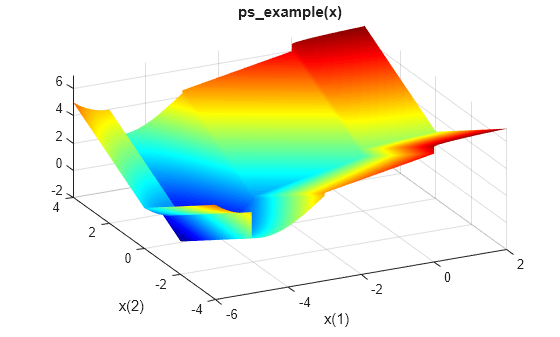このページは機械翻訳を使用して翻訳されました。元の英語を参照するには、ここをクリックします。
patternsearchを使った非滑らかな関数の最適化、問題ベース
この例では、問題ベースのアプローチで直接探索を使用して、滑らかでない関数を最小化する方法を示します。この例を実行すると、最小化する関数 ps_example(x) が含まれます。
目的関数をプロットします。
fsurf(@(x,y)reshape(ps_example([x(:),y(:)]),size(x)),... [-6 2 -4 4],"LineStyle","none","MeshDensity",300) colormap 'jet' view(-26,43) xlabel("x(1)") ylabel("x(2)") title("ps\_example(x)")

2 次元最適化変数 x を作成します。ps_example 関数は変数が行ベクトルであると想定しているため、x を 2 要素の行ベクトルとして指定します。
x = optimvar("x",1,2);ps_example を目的関数として使用するには、fcn2optimexpr を使用して関数を最適化式に変換します。
fun = fcn2optimexpr(@ps_example,x);
目的関数 ps_example を使用して最適化問題を作成します。
prob = optimproblem("Objective",fun);初期点 x0 を、フィールド x が値 [2.1 1.7] を取る構造体として指定します。
x0.x = [2.1 1.7];
patternsearch ソルバーを指定して問題を解きます。
[sol,fval] = solve(prob,x0,"Solver","patternsearch")
Solving problem using patternsearch. patternsearch stopped because the mesh size was less than options.MeshTolerance.
sol = struct with fields:
x: [-4.7124 -7.6294e-07]
fval = -2.0000
patternsearch はデフォルトの fminunc ソルバーよりも優れたソリューション (より低い関数値) を見つけますが、滑らかでない関数を最小化する場合には推奨されません。
[solfminunc,fvalfminunc] = solve(prob,x0)
Solving problem using fminunc. Local minimum possible. fminunc stopped because it cannot decrease the objective function along the current search direction. <stopping criteria details>
solfminunc = struct with fields:
x: [1.9240 8.8818e-16]
fvalfminunc = 2.9161
参考
patternsearch | fcn2optimexpr | solve